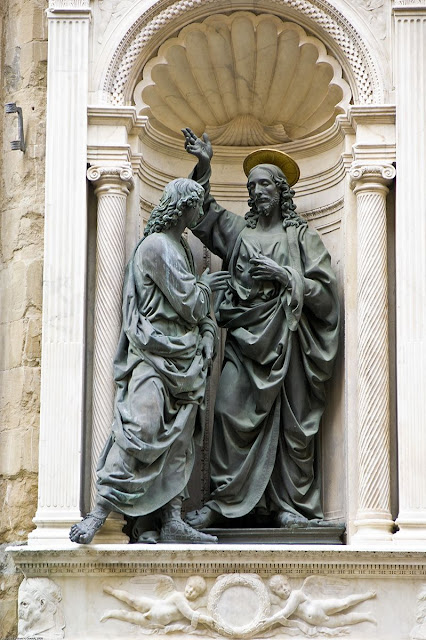ANDREA VERROCCHIO'S DOUBTING of THOMAS I
In 1467 Andrea Verrocchio is commissioned by the merchants' court of Florence to cast a bronze statue group of two figures, Saint Thomas and Christ, for a niche on the building of Orsanmichele in Florence. The entire enterprise takes almost twenty years to complete and in 1483 the two statues are placed in the niche. (The originals are in the Museum of Orsanmichele now and copies of both are placed outside the building.)

Thomas's body approaches the body of Christ and his feet are in motion in forward movement, as is his right hand. His right knee bends out toward the viewer under the voluminous drapery and his right index and middle fingers point to the wound opening; his head turns from his torso towards Christ and
his whole body appears to be moving.
Why would this dialogue of question and answer be a scene of interest to the merchants'court of Florence? Why, of all the Bible stories available to them, did they want this one in the niche of their guild? The Merchants' Court, the Mercatanzia or Mercanzia, had their own building for their proceedings (complete with jail) right next door to the Palazzo della Signoria in the center of town.
As a group, they must have had plenty of money from the cases which were adjudicated in their building because during the same period in which they commissioned this statue group from Verrocchio, they commissioned from the Pollaiuolo brothers and Botticelli a painted group of Virtues (1470) to be placed over the judges' benches in the room where cases were tried.
(See Antonella Astorri and David Friedman's interesting article in I Tatti Studies in the Italian Renaissance, Vol. 10 (2005), pp. 11-68.) In all their cases disputes had to be resolved by resorting to tangible and visible proof to reach the truth of a verdict. The requirement for tangible proof in the court meant that the story of St. Thomas was pertinent to their proceedings. Thomas had required tangible proof from Jesus in order to believe in his truth. The merchants required tangible evidence for the settlements of their disputes.
Unlike the Virtues that were private painted reminders of the qualities most associated with the Mercatanzia judges, the statues of St. Thomas and Christ were public reminders of theimportance of the Mercatanzia's methods of problem-resolution for the major industry, the cloth industry, in Florence and abroad.
The niche on Orsanmichele where the Verrocchio group stood is just above the heads of passersby on one of the busiest streets in the city, the street which leads from the secular center of town, Piazza della Signoria, to the sacred center of town, the Duomo. Orsanmichele, a building which
housed the grain supply for the town  and also held the most sacred of Madonna images,
and also held the most sacred of Madonna images,
combined both the secular and sacred in its functions. Orsanmichele was both silo and church.
Verrocchio is aware of the position of his two male figures in the town context. Thomas represents the secular (silo) questioning of faith and Christ represents the unquestioning acknowledgement of belief (the church.) Their two gestures swathed in large, sweeping folds of cloth, the cloth that was at the heart of Florentine industry and trade in the period,
allow the public that passes by to be reminded of the two major currents in their own lives, the reality of selling cloth to survive, and the reality of the Christian belief that underpinned all transactions related to that selling.
Verrocchio himself is selling faith, faith exhibited in the niche's subject, faith exhibited by his commissioners, faith in his own abilities to sculpt, faith in the story of Christ coming back after death, faith in the jurisdictions of the merchants' court itself. And the beauty of his figures transfixes the viewer, captivates and holds his/her attention. The artist here is the ultimate salesman, luring and seducing the audience to admire the version of the story as crafted in his hands. He knows that beauty is nourishment and his figures give satiation to the people who walk past them.
How beautiful the concepts of justice and belief!
The artist even left a foot out for you to reach up and touch, in case seeing the beauty were not enough.

































No comments:
Post a Comment